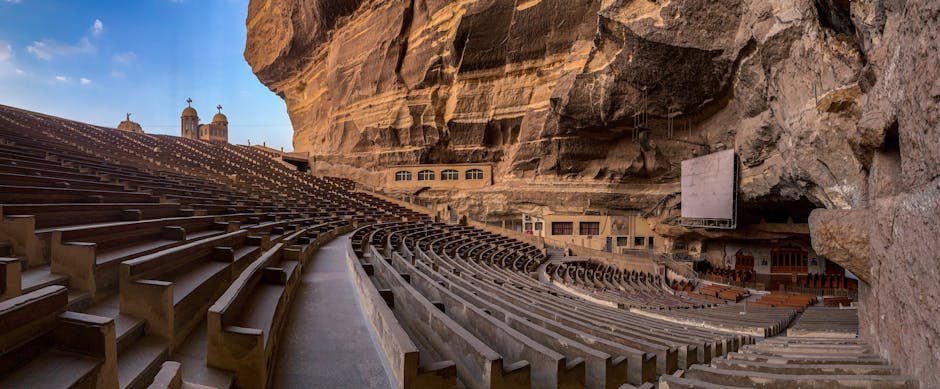Summary
- Location: The Cave Church is situated at the top of the Moqattam Mountain in Zabbaleen City, also known as “The City of Garbage,” on the east bank of the Nile River in Cairo, Egypt.
- Name Origin: The church is named after Simon the Tanner, a Coptic saint who lived in the 10th century AD and is associated with the moving of the Mokattam Mountain by order of the Islamic Fatimid Caliph Al Muizz.
- Historical Significance: The history of the Cave Church dates back to the time of the Holy Family’s journey in Egypt, and it was constructed in the 10th century AD during the rule of Caliph Al Muizz. The area was settled by descendants of farmers who migrated to Cairo in the 1940s.
- Carvings and Art: The Cave Church is a remarkable piece of art, adorned with sculptures and carvings that depict biblical stories, including the birth of Jesus, the resurrection of Lazarus, the story of Zuleikha and Joseph, and more.
- Monumental Size: This church is one of the largest in Egypt, the Middle East, and the world, with a seating capacity of 20,000, making it a significant religious and historical landmark.
The Cave Church of Saint Simon the Tanner or the monastery of Samaan Al Kharraz is a miraculous monument found in the womb of divine mountains acting as a holy book made of stone showcasing the power of the faith that can move the strongest mountains.
It is one of the biggest churches in Egypt, the Middle East, and the world able to shed some light on a holy display of allure made by the strength of belief, carved in the core of the deepest part of Cairo city. In the heart of this magnificent monument are the immortal tales and history of some of the most incredible miracles and honorable men of faith the world has ever seen.
The Location of Cave Church
Some may wonder, where is the Cave Church located, and the answer is, that the Cave church is found at the very top of the Mountain of Moqattam in an area known as Zabbaleen City “The City of Garbage” on the east bank of the Nile River which has the biggest population of garbage collectors and recyclers in all of Cairo.
It contains six churches that are carved directly into the rocky core of the mountain. Next to the Monastery of St. Simon the Tanner are a number of churches which are St. Paul’s Church, St. Mark’s Church, and St. Simon the Tanner’s Hall.
The Name of the Cave Church
The name of cave church was named after Simon the Tanner the Coptic saint who lived in the 10th century AD under the rule of Al Muizz the Islamic Fatimid Caliph who was connected to the moving of the Mokattam Mountain.
The story goes that Al Muizz ordered the Coptic Pope Abraham of Alexandria to move Moqattam Mountain as a test of his faith so he fasted for three whole days and then fainted when the virgin Mary informed him of a man who could move the mountain called Simon the Tanner who had two jobs, the first the shoe repairman and a water distributor to the poor.
He moved the mountain from the area of Ramses after the transfer was complete Saint Samaan disappeared through one of the mountain Caves then a monastery was constructed in the same place.
The History of the Cave Church
The history of the monastery of Saint Simon the Tanner dates back to the times of the holy family who hid in this location during their three-year journey in Egypt. It was constructed in the commemoration and memory of Saint Simon in the 10th century AD during the reign of Al Muizz the Fatimid Caliph.
The Zabbaleen City was created by the descendants of farmers who migrated in the 1940s AD from Upper Egypt to Cairo due to poverty and to avoid the municipal authorities but as they became city inhibitors, they didn’t forget their traditions of animals like chickens, ducks, goats, and more. The new city immigrants started salvaging anything that had any sense of value plus all the organic matters acted as food for their animals. As a result of this harmonious arrangement, many immigrants across the years took the place as their new home.
90% of all the residents in the Zabbaleen are Coptic. And a local church was built in 1975 and in 1976 a fire broke and many constructions were destroyed. In the same year, a decision was made 1000 squ m under the Mokattam Mountain into its cave which became known as the Monastery of St. Simon the Tanner which possesses 20,000 seats and makes it the biggest church in the Middle East.
The Carving in the Cave Church
The church is a true piece of art conveying a number of marvelous sculptured statues of Mary Magdalene and the Virgin Mary. The church holds a number of incredible stories carved into the mountain rocks which tell the birth story of Jesus.
There are carvings that tell the story of the Lazarus miracle of resurrection by Jesus. A number of biblical verses are carved across the walls of the church. There is also the carved story of Zuleikha and Joseph plus the story of Potiphar’s wife. The walls of the church hold the story of the legendary Samson.









